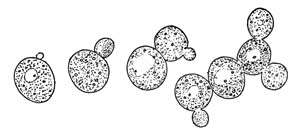I recently received a request from one of my readers for a gluten-free yeast-free bread recipe. I noticed that many people avoid yeast. Personally, I wish to slowly remove fermented foods and ingredients from my diet and had the question, “Is yeast bad for you?” I did some research and this article turned out to be about Candida, as well. I wanted to share the information I found on yeast, as well as how Candida (yeast infections), also known as thrush, can trigger celiac disease.
Yeast is not a bacteria, but belongs to the fungus family. Though, bacteria and fungus are similar in that they are each, single cells, versus multicellular. There are multiple types of yeast. There is also much conflicting information on whether consuming yeast is good or bad for you.
Types of Yeast
- Bakers yeast: a live yeast that comes in packets or a compressed brick
- Brewers yeast: a live yeast that is used in the brewing of beer and malt beverages which turns to alcohol
- Nutritional yeast: Red Star brand of processing is grown on beet and cane molasses, Vitamin Bs are added to help it grow, and heated so that it is no longer alive; has similar nutrients to Vitamin B Complex and great source of amino acids; no sugar content; and tastes similar to cheese; vegan use it on popcorn, pizza and as a substitute for Parmasean cheese
- Candida yeast: definitely a bad yeast which may live in our bodys; 75-80% of women have had a yeast infection at some point in their lives; people who have weakened immune systems are more susceptible.
The Denver Naturopathic Clinic states that the inner wall of Candida cells contain the same protein (“hypha-specific surface protein” Hwp1) as wheat gluten and could trigger celiac disease. Candida cells that do not contain the Hwp1 protein cannot attach themselves to the digestive tract. Thus, it is extremely important not to eat anything which could trigger Candida, especially if you are already susceptible to it.
While bakers yeast, such as instant yeast, is very helpful in the rising of gluten-free breads, it may have a negative effect on those with yeast infections or Candida.
Foods which contain yeast, such as beer, bread and other baked goods often contain high amounts of sugar and possibly preservatives (chemicals). However, there are gluten-free foods on the market which now contain sweeteners which have less effect on the glycemic index (sugar levels), such as agave (a little less), and especially stevia and xylitol, etc.
Someone with a yeast infection or candida should avoid sugar, and many believe that the body certainly does not need any more yeast, as in yeast from sourdough bread (fermented), grapes, cider, beer, etc. While others believe that nutritional yeast is fine because it is not alive. Yet, others believe that all consumable yeast is fine because it is not candida yeast.
Once activated, live yeast grows (creates bubbles and expands) which can also be gas causing. Certainly those with IBS (irritable bowel syndrome) should avoid yeast.
Candida, formally known as Candida albicans or Candidiasis, can cause inflammation in the bloodstream and in our organs. Those diagnosed with Candida should avoid sugar and other foods which contain yeast and sugar. Candida thrives and grows on sugar and refined carbohydrates (flour, starch, etc.). This is another good reason to use why whole grain flours in your baked goods.
Knowing that brewers and bakers yeast is live fungi, I am sold on the fact that our bodies can definitely do better without it!
For those with celiac disease who continue to have symptoms though they have avoided all gluten, Candida is an item to look at. Perhaps avoiding sugar, and maybe even yeast, may be your ticket to being symptom free!
With the above said, I will definitely be in the kitchen soon experimenting with yeast free bread recipes! I already started experimenting with a lower glycemic index bread by using agave successfully in my Gluten-free Bread Recipe made with Teff Flour. Check it out! And definitely read the article linked above. It’s full of insightful information!




Hi, I am Celiac and never found a decent bread. It must be the flour. I have just made soda bread and it had the same taste.
I could buy Tess flour, if I could find it as I live in Malta. That would actually mean that by the time I had finished baking the bread it would cost me roughly 13 euro per loaf.. wow..
thanks, I know I’ve had candida for years…..big sugar eater…will taper off immediately. keep sending info, It’s great…mary ann mitcham
Thought you should read this….made me stop using Agave Nectar!
http://nourishedkitchen.com/when-natural-foods-arent-natural-agave-nectar/
Thanks Susan. I wrote a similar article on my other blog. It is much like sugar in the sense of its sugar content, as evidenced by activating yeast in my bread recipes. It does, however, react slowly in the body when compared to refined sugar. Stevia is great, though some of us have bloating issues with it. Xylitol is best for those with bloating issues, as it is the only natural sugar substitute where you can slowly introduce into your diet, a little at the time (per my doctor) so that your body may get used to it, without bloating issues.